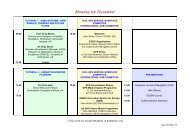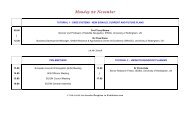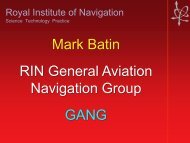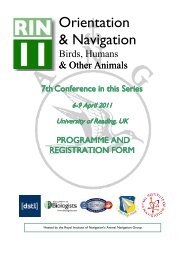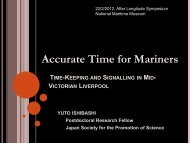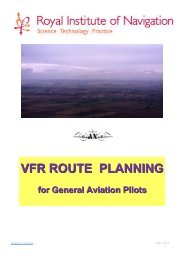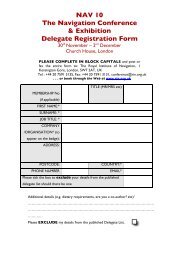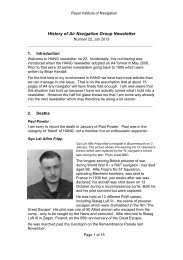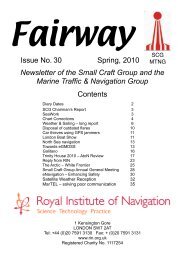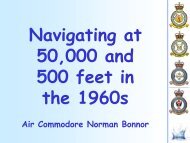HANG Newsletter - Royal Institute of Navigation
HANG Newsletter - Royal Institute of Navigation
HANG Newsletter - Royal Institute of Navigation
You also want an ePaper? Increase the reach of your titles
YUMPU automatically turns print PDFs into web optimized ePapers that Google loves.
<strong>Royal</strong> <strong>Institute</strong> <strong>of</strong> <strong>Navigation</strong><br />
This link, from the Australian Aviation Museum, seems to reflect my<br />
instrument:<br />
http://www.aamb.com.au/DRIFT.HTM<br />
Unfortunately, when I contacted them, they indicated that they had received<br />
their Mk IV as a donation and had no further information on the device.<br />
For the record, I am an electrical engineer by pr<strong>of</strong>ession, and a person who<br />
finds great beauty in the design and fabrication <strong>of</strong> precision machinery. I am<br />
also a student <strong>of</strong> history, and one who thinks that treasures like my drift sight<br />
are to be appreciated, preserved and ultimately passed on. I'd like to properly<br />
identify my drift sight, what aircraft it came from, and what Ministry<br />
publications might make mention <strong>of</strong> its proper use. Ideally, I hope to be able to<br />
pick up some <strong>of</strong> this documentation on eBay. Frankly, I'd be happy to have a<br />
few scanned pages if all else fails. The end game is to add some pages to<br />
my web site to make this information public.<br />
On a related note, here are a couple <strong>of</strong> web pages that I have already<br />
constructed to provide information on some retired military radios I've<br />
acquired, one from WW2, the other from the Iraq war:<br />
http://www.hpfriedrichs.com/rr-bc-348.htm<br />
http://www.hpfriedrichs.com/rr-tr-vp-13.htm.<br />
Firstly – I checked on these links. Both <strong>of</strong> them are examples <strong>of</strong> thorough and<br />
almost forensic research to bring an old radio artefact back into use. Good<br />
reading and I recommend them.<br />
I wrote back to Pete telling him that this instrument is a Tail Drift Sight Mk4,<br />
ref 6B/110 and was used in the 1930’s. To quote AP1234 (1935) Manual <strong>of</strong><br />
Air <strong>Navigation</strong>… “The tail drift sight is used for taking readings on an object<br />
over which the aircraft has passed. The object is followed astern through the<br />
optical system <strong>of</strong> the sight, the drift angle being read from a scale. In the Tail<br />
Drift Sight Mk4 it is not necessary for the aircraft to pass directly over the<br />
object as a correction for the initial displacement <strong>of</strong> the object is automatically<br />
applied when the sight is used. Details <strong>of</strong> the construction and use <strong>of</strong> the tail<br />
drift sight MkIV will be found in AP1275 section 9 chapter I”<br />
AP1234 (1935) describes finding the drift by using, in order, the Course<br />
Setting Bombsight, the Drift Indicator Bearing Plate or the Tail Drift Sight.<br />
However by the time <strong>of</strong> the issue <strong>of</strong> the AP1234 (1941) Air <strong>Navigation</strong> drift is<br />
said to be measured by the Drift Recorder Mk II (an entirely different<br />
instrument), the Course Setting Bombsight or by Back Bearings. The Tail<br />
Drift Sight had dropped from favour. When you combine this with the<br />
markings <strong>of</strong> Pete’s Tail Drift Sight which indicate dates <strong>of</strong> 1939, 1940 and<br />
1936 it seems that the Tail Drift Sight was a significant player in the<br />
measurement <strong>of</strong> drift over the years 1935-1940.<br />
Pete wonders what aircraft may have used the Tail Drift Sight. My guess<br />
would be any RAF aircraft with a navigator that was operational in the years<br />
1935-1940. Pete referred to the Bristol Beaufort and that just comes within<br />
this bracket. Bristol Beauforts first saw service with Coastal Command and<br />
then the Fleet Air Arm from 1940, until they were withdrawn from operational<br />
service in the European theatre in 1942. RAF Beauforts operated as torpedo<br />
Page 11 <strong>of</strong> 16




